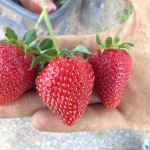The Environmental Working Group (EWG) is a non-profit Washington, D.C. group whose mission is,  as stated on their website: “ to use the power of public information to protect public health and the environment.” Every year they publish a list called the Dirty Dozen/Clean Fifteen list which highlights the fruits and vegetables with the highest and lowest amounts of pesticide residue.
as stated on their website: “ to use the power of public information to protect public health and the environment.” Every year they publish a list called the Dirty Dozen/Clean Fifteen list which highlights the fruits and vegetables with the highest and lowest amounts of pesticide residue.
The Dirty Dozen list alerts us to the produce that has higher concentrations of pesticides and higher numbers of pesticides than other fruits or vegetables.
The Clean Fifteen list informs us as to which vegetables and fruits can be bought conventionally grown without the worry of massive exposure to pesticides.
Check out the EWG full list of just released EWG 2016 Dirty Dozen/Clean Fifteen full list here.
Apples, which have claimed the number one spot on the dirty dozen list for the last five years for having the most pesticide residue, have been moved to the number two slot. Strawberries have moved to the top position. According to the report, 40% of strawberries had residues of ten or more pesticides and the dirtiest sample tested for 17 different types. With year round availability, Americans now eat about eight pounds of fresh strawberries a year says the report - nearly 4x as much as in 1980.
Trace levels of highly hazardous pesticides were detected in leafy greens like kale and collard greens and hot peppers. They did not meet the criteria for the dirty dozen list, but the EWG has added them to a special “plus” section at the bottom and they recommend buying organic varieties of leafy greens and hot peppers. Read the summary report here.
Pesticide Exposure in Children
In 2012, the Academy of Pediatrics warned doctors and parents of the potential dangers to children from pesticide exposure, saying that exposure in early life could lead to “pediatric cancers, decreased cognitive function, and behavioral problems.” Of particular concern, I would think, is the use of several pesticides at the same time, creating a synergistic effect that may be more toxic than just one pesticide alone. The Center for Disease Control (CDC) says that the United States uses over 1 BILLION pounds of pesticides per year, which includes environmental uses as well as agricultural.
When organic produce isn’t available or isn’t affordable the EWG advises cooking conventional produce, saying that pesticide levels usually diminish when the food is cooked.
Stay Informed
Fruits and vegetables provide vitamins, minerals and antioxidants and are a vital source of nutrition for good health. Please consider buying organic, especially the dirty dozen, and whether buying organic or conventional be sure to always wash produce thoroughly before eating.
I encourage you to sign up with your email so that you can download the Environmental Working Group's Dirty Dozen/Clean Fifteen Shopping Guide to carry in your wallet for easy access while you shop for fruits and vegetables.
.png?width=305&height=132&name=NIHAlogoBLUE_3_transparent%20(2).png)
